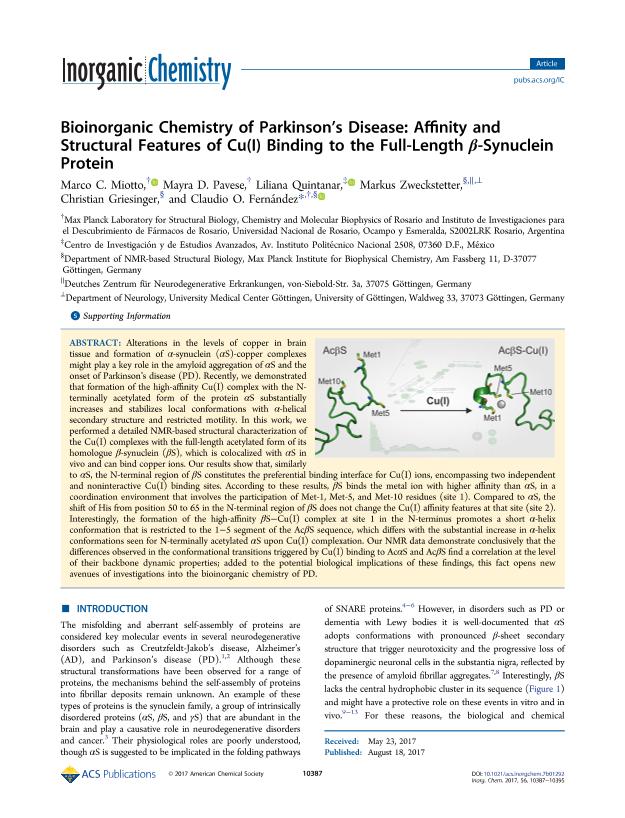Artículo
Bioinorganic Chemistry of Parkinson's Disease: Affinity and Structural Features of Cu(I) Binding to the Full-Length β-Synuclein Protein
Miotto, Marco César ; Pavese, Mayra D.; Quintanar, Liliana; Zweckstetter, Markus; Griesinger, Christian; Fernandez, Claudio Oscar
; Pavese, Mayra D.; Quintanar, Liliana; Zweckstetter, Markus; Griesinger, Christian; Fernandez, Claudio Oscar
 ; Pavese, Mayra D.; Quintanar, Liliana; Zweckstetter, Markus; Griesinger, Christian; Fernandez, Claudio Oscar
; Pavese, Mayra D.; Quintanar, Liliana; Zweckstetter, Markus; Griesinger, Christian; Fernandez, Claudio Oscar
Fecha de publicación:
09/2017
Editorial:
American Chemical Society
Revista:
Inorganic Chemistry
ISSN:
0020-1669
Idioma:
Inglés
Tipo de recurso:
Artículo publicado
Clasificación temática:
Resumen
Alterations in the levels of copper in brain tissue and formation of α-synuclein (αS)-copper complexes might play a key role in the amyloid aggregation of αS and the onset of Parkinson's disease (PD). Recently, we demonstrated that formation of the high-affinity Cu(I) complex with the N-terminally acetylated form of the protein αS substantially increases and stabilizes local conformations with α-helical secondary structure and restricted motility. In this work, we performed a detailed NMR-based structural characterization of the Cu(I) complexes with the full-length acetylated form of its homologue β-synuclein (βS), which is colocalized with αS in vivo and can bind copper ions. Our results show that, similarly to αS, the N-terminal region of βS constitutes the preferential binding interface for Cu(I) ions, encompassing two independent and noninteractive Cu(I) binding sites. According to these results, βS binds the metal ion with higher affinity than αS, in a coordination environment that involves the participation of Met-1, Met-5, and Met-10 residues (site 1). Compared to αS, the shift of His from position 50 to 65 in the N-terminal region of βS does not change the Cu(I) affinity features at that site (site 2). Interestingly, the formation of the high-affinity βS-Cu(I) complex at site 1 in the N-terminus promotes a short α-helix conformation that is restricted to the 1-5 segment of the AcβS sequence, which differs with the substantial increase in α-helix conformations seen for N-terminally acetylated αS upon Cu(I) complexation. Our NMR data demonstrate conclusively that the differences observed in the conformational transitions triggered by Cu(I) binding to AcαS and AcβS find a correlation at the level of their backbone dynamic properties; added to the potential biological implications of these findings, this fact opens new avenues of investigations into the bioinorganic chemistry of PD.
Palabras clave:
Synuclein
,
Copper
,
Parkinson
Archivos asociados
Licencia
Identificadores
Colecciones
Articulos(IBR)
Articulos de INST.DE BIOLOGIA MOLECULAR Y CELULAR DE ROSARIO
Articulos de INST.DE BIOLOGIA MOLECULAR Y CELULAR DE ROSARIO
Citación
Miotto, Marco César; Pavese, Mayra D.; Quintanar, Liliana; Zweckstetter, Markus; Griesinger, Christian; et al.; Bioinorganic Chemistry of Parkinson's Disease: Affinity and Structural Features of Cu(I) Binding to the Full-Length β-Synuclein Protein; American Chemical Society; Inorganic Chemistry; 56; 17; 9-2017; 10387-10395
Compartir
Altmétricas



